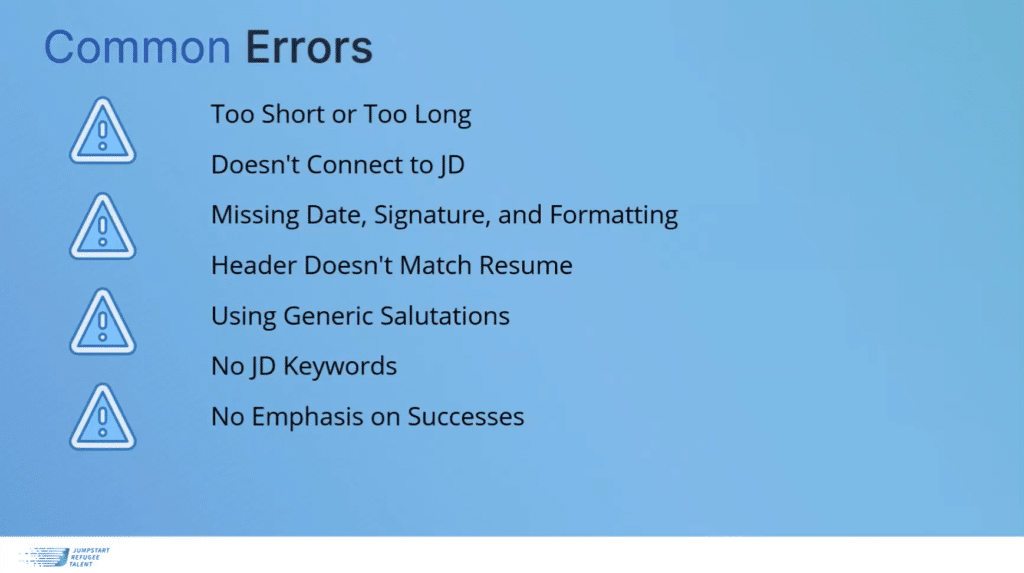This blog was created based on content delivered by Kerry Ross, a career educator at the University of British Columbia in Vancouver, B.C., on April 17, 2024, for Jumpstart’s online workshop: Mastering Cover Letters: Building Your Path to Job Success.
Kerry joined Jumpstart as a volunteer in 2022 and is certified as a Career Development Practitioner (CCDP) in British Columbia.
Introduction
Navigating job application processes can be tricky and can get more nuanced when you come from another country and culture. Whether you are a seasoned professional or just starting along your career journey, cover letters play a pivotal role in the Canadian hiring processes and a critical way to showcase your skills and experiences to potential employers.
In today’s competitive job market, a well-crafted cover letter can make all the difference. By following the strategies outlined in this post, you can increase your chances of getting noticed, and securing an interview.
Understanding the Purpose
Before delving into the specifics of crafting the perfect cover letter, it is crucial to understand why cover letters are essential. When applying for a job, you’re essentially telling a story to a future employer. Your cover letter, along with your resume, serves as a narrative of your skills, abilities, and experiences, tailored to fit the requirements of the job you’re applying for. So, tell your story and tell it in a way that feels and sounds like you!
The Anatomy of a Cover Letter
A cover letter is more than just a document; it is a tailored presentation of your candidacy for a specific role. Unlike resumes, which often use bullet points to highlight accomplishments, cover letters employ full sentences to convey your suitability for the job. They are personalized documents, meticulously crafted to address the needs of each employer and position you’re applying for. But there are some formatting tips to follow (see next tip!)
Formatting Matters
Looks matter, especially when it comes to cover letters. A well-formatted cover letter catches the eye of hiring managers, who often scan documents in seconds. Ensure your cover letter includes essential details such as the date, recipient’s address, and your contact information. Keep it concise, use multiple paragraphs for easy readability, and aim to keep it to one page.
Content and Approach
Your cover letter should follow a professional business format and get straight to the point. Focus on highlighting your skills rather than listing your experiences. Remember, employers are interested in how your skills translate to success in the role they are offering. Use the cover letter to bridge the gap between the job description and your qualifications, demonstrating why you are the perfect fit for the position. Providing evidence of your skillset in action is imperative! Do not shy away from sharing experiences that align with the needs of the advertised position.
Build Your Skills Database
To create an effective cover letter, start by compiling a skills database. List all your skills — both soft and hard skills — along with examples of when and where you developed them. This database serves as a valuable resource when tailoring your cover letter to specific job descriptions, helping you prioritize the most relevant skills for each application.
Engaging Openers and Effective Closers
Your cover letter should begin with an engaging opener that grabs the reader’s attention and sets the tone for the rest of the letter. Use this opportunity to tell your story (see Tip #1 Understand the Purpose) and highlight what makes you unique. Similarly, end your cover letter with a strong closing statement that reinforces your interest in the position and leaves an impression on the reader. Once again, don’t be afraid to be yourself – genuineness and personality count!
Tailoring to the Job Description
One of the keys to a successful cover letter is aligning your skills with the job description’s requirements. Pay close attention to keywords and phrases used in the job posting and incorporate them into your cover letter. This not only shows that you have read the job description, but it also demonstrates how your skills directly address the employer’s needs.
Conclusion
Crafting an effective cover letter requires careful attention to detail and a thorough understanding of the job you are applying for. By following these guidelines and leveraging your skills database, you can create compelling cover letters that make a strong impression on potential employers. Remember, your cover letter is your opportunity to tell your story and showcase why you’re the perfect candidate for the job. Good luck!
For more information on upcoming events, including more career readiness events, please visit Events & Workshops.






